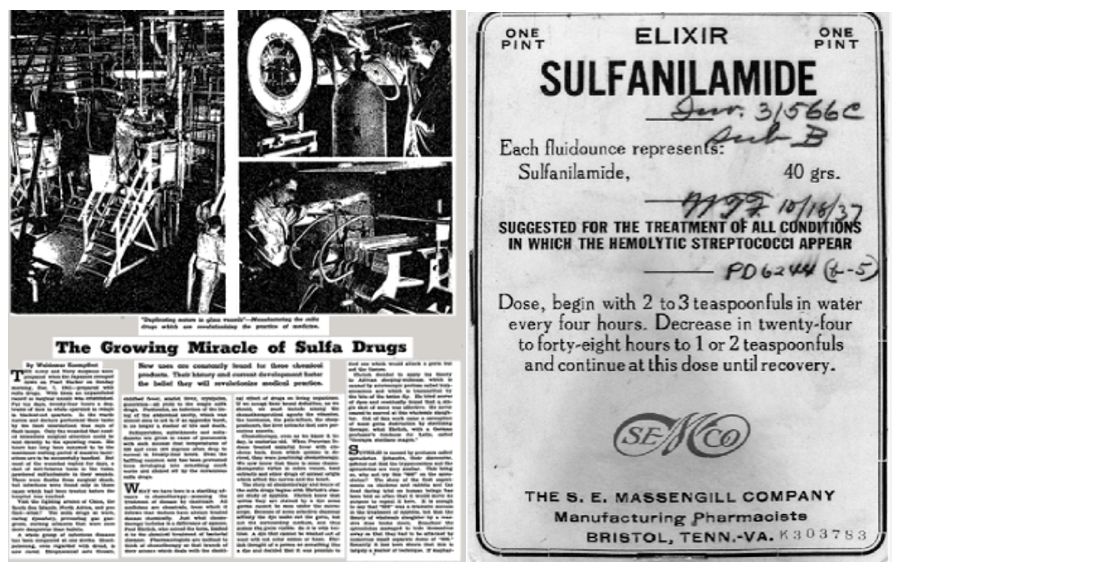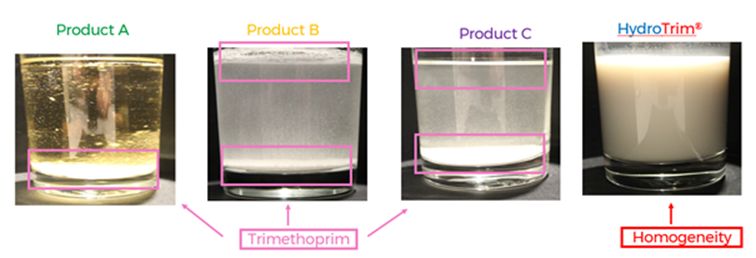Sulfonamides were the first broad-spectrum and systemic antibiotics. Prontosil was the first marketed brand, developed by Bayer AG which was still a component of IG Farben at the time.
Initially, sulfonamides were mainly used in the dye industry until in 1932 a Bayer chemist (Josef Klarer) discovered that a certain red dye had a remarkable effect on stopping bacterial infections in mice. The result was a 'sulfa craze' (Figure 1), hundreds of manufacturers started to produce al kinds of sulfonamides without any testing requirements. This led to the introduction of the Federal Food, Drug and Cosmetic Act in 1938 in the United States, forcing manufacturers to submit evidence of new drugs' safety and effectiveness before marketing and distribution.
As the first and only effective broad-spectrum antibiotic available in the years before penicillin, the use of sulfa drugs continued into the early years of World War II. They saved the lives of tens of thousands, including Franklin Delano Roosevelt Jr. (son of US President Franklin Delano Roosevelt) and Winston Churchill. Soon after, penicillin started booming. Much later, in 1962, trimethoprim was discovered, commonly used in combination due to synergistic effects and reduced development of resistance. Until today, sulfonamides in human and animal health are still used mainly in combination with trimethoprim.

Several sulfonamides were developed, all with different properties and toxicity profiles. Sulfaquinoxaline, synthesized during the war, was one such compound. It proved too toxic to be used in humans but was found to be a superior agent against Eimeria spp., the causative agent of coccidiosis in domestic chickens. In 1948 it was introduced commercially as a poultry coccidiostat, and the drug had a major impact on the worldwide production of poultry meat.
In livestock production, several sulfonamides are being used, such as sulfaximethoxine, sulfadiazine, sulfamethoxazole, sulfamethazine, sulfaquinoxaline, sulfathiazole, sulfamerazine, sulfasalazine, and sulfachloropyridazine, mostly in combination with trimethoprim, due to its synergistic effect. Sulfonamides/trimethoprim are being classified in the EMA categorization (published 28/01/2020) as Category D, which means they should be used as a first line treatment in livestock. It is important to know that the various sulfonamide derivatives differ in their pharmacokinetic properties (Table 1). Typical differences are their ability to penetrate tissues (Vd, volume of distribution) and elimination half-time (t1/2).

Sulfonamides and trimethoprim are typically used in feed and as an injectable in livestock. In recent years their application via drinking water has gained importance. There are three conditions to making this feasible:
- Sufficient solubility in (drinking) water. Sulfonamides and trimethoprim as such are insoluble in water (Figure 2). There are three different approaches which allow application via drinking water:
- Most commonly, sulfonamides are combined with sodium (Na+) to obtain a water-soluble salt form. This works for most sulfonamides except sulfamethoxazole and trimethoprim.
- Make a liquid formulation containing a high amount of a strong base like sodium hydroxide (NaOH). This keeps the sulfonamide in solution in the stock solution, but once diluted in the drinking water, the antibiotic precipitates in the drinking lines again with the risk of leaving residues and blocking drinking nipples. Also, such strong bases can negatively affect water intake. This approach is typically used for sulfamethoxazole.
- Develop a nanosuspension. Trimethoprim is not soluble enough - it has a maximum solubility of 0.4 mg/ml, while 5 mg/ml is the required dose for stock solutions. To overcome this, Huvepharma developed HydroTrim® which contains nanonised trimethoprim that stays in homogenous suspension, even at very high concentrations.
- Stability over 24 hours at different pH values and hardness of water.
- Palatability is often a concern. There seems to be a difference between the different sulfonamides and which excipients are used in the formulation. Adding NaOH to your formulation, for example, can lead to reluctance to drink and decreased water intake.

Sulfonamides are often combined with trimethoprim for their synergistic effect. It is important to have the right ratio of sulfa to trimethoprim. Normally a ratio of 5 to 1 is applied but this can differ depending on the bioavailability and tissue penetration of the sulfonamide.
In livestock production, sulfonamides are of increasing importance because of their low risk for development of resistance in human medicine. Development of new formulation techniques is allowing the use of this family of antibiotics in modern livestock production, in more convenient and safe ways. This illustrates how innovation doesn't necessarily mean developing new therapeutic drugs, but it can also mean optimizing the use and efficacy of already existing drugs.


